Just a short while ago, during our educational years, we were taught that there are a total of nine planets in our solar system. Six of these celestial bodies have been recognized since ancient times, while Uranus was unveiled in 1784 and Neptune in 1846. Ultimately, in 1930, the last planet, Pluto, was discovered. However, unexpectedly, it was later revealed that Pluto is no longer classified as a planet, or more specifically, one of the major planets. This leads us to ponder: What is the reason behind Pluto’s removal from the roster of planets? What is the issue with it?
What Defines a Planet?
Let’s take a step back and ponder the question: what truly constitutes a planet? Undoubtedly, nearly everyone will offer their own interpretation. Some may argue that it is a compact, dimly lit entity, while others may contend that a planet must orbit the sun. Why such diverse perspectives? The answer is straightforward: until recently, the definition was so imprecise that a multitude of celestial bodies fell under its umbrella!
Ancient Understanding of Planets
In antiquity, individuals gazed at the celestial expanse with little comprehension of the stars’ true nature. While various hypotheses were posited, the inquiry remained unresolved. Planets were perceived as stars that exhibited distinct motion relative to the backdrop of other stars.
Put yourself in the shoes of an ancient Babylonian or Greek astronomer. Picture yourself gazing up at the night sky, night after night, year after year, with the goal of creating an accurate calendar. And what do you observe? The majority of the stars remain stationary in relation to each other. They are so fixed, in fact, that they can be grouped together into constellations, providing a helpful guide for navigation, and these constellations remain unchanged throughout the centuries. However, amidst the countless fixed stars, you also notice a handful of bright lights that move against the backdrop of the constellations. In appearance, they resemble stars, but with one key difference – they are in motion. Now, the term planet is derived from the Greek word meaning wandering – wandering stars.
Planets in the Post-Copernican Era
For countless years, there has been ongoing speculation about the nature of the planets. It was previously believed that all the planets, including the Sun and Moon, revolved around the Earth. This system was intricate yet unwieldy. However, Copernicus presented a groundbreaking idea that simplified the understanding of planetary motion by placing the Sun, rather than the Earth, at the center of the universe.
This revelation brought about a major paradigm shift. It was discovered that:
- The Earth is also a planet! Just like Jupiter or Mars, it orbits around the Sun. This concept was previously unheard of! The Earth was regarded as a stationary object, the epicenter of the world, but not as a planet!
- The moon is not classified as a planet, but as a satellite. This is due to its primary orbit around the Earth.
- The sun, it seems, is not classified as a planet either, due to its immense size and high temperature, as well as its position at the center of our solar system.
Planets in the 20th century
By the 20th century, there was a widespread belief that planets are celestial bodies that are not self-luminous, have a spherical shape, and orbit around a central star. This definition was based on the understanding that luminous bodies are classified as stars, and bodies orbiting other planets are considered satellites.
This definition proved to be quite accurate! It was found that both the large gaseous planet Jupiter and the small solid planet Mercury perfectly fit this description. Additionally, some satellites, such as Titan or Ganymede, were discovered to be larger than Mercury. However, this did not change their classification, as Mercury orbits the Sun while the satellites orbit other planets!
In 1930, the American astronomer Clyde Tombaugh made a groundbreaking discovery by finding Pluto.
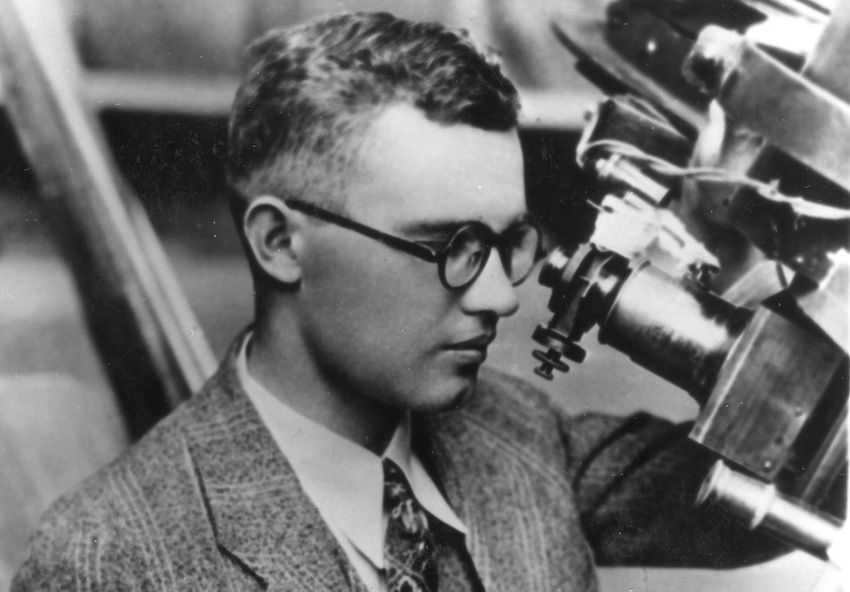
The discovery had been eagerly anticipated as astronomers had been intentionally searching for the new planet for decades. Astronomers were confident in the existence of another planet beyond the orbit of Neptune due to irregularities in Neptune’s motion, which were believed to be caused by the gravitational pull of a more distant and unknown planet.
However, the initial images of Pluto raised doubts. According to predictions, the ninth planet should have been much larger and brighter than Pluto, given its greater mass compared to Earth. Astronomers acknowledged the discrepancy and speculated that perhaps Pluto was simply very dark and therefore appeared dim in the photos. They concluded that further observations were needed to provide more accurate data.
However: Is Pluto considered a planet or not?!
For the following 40 years, the true nature of Pluto remained uncertain. The peculiar aspect of the new celestial body was its orbit. All typical planets revolve around the Sun in a similar plane. However, Pluto’s orbit is highly inclined, resembling the tilted orbits of comets and asteroids. Additionally, Pluto’s orbit is elongated – to such an extent that it appears more oval-shaped than circular. As a result, there are instances when Pluto is closer to the Sun than Neptune! (Most recently, this occurred between 1979 and 1999.).
This raises the question: what is the basis for our belief that Pluto is a planet? Is it possible that it is actually a large asteroid, similar to Ceres or Vesta? The spark that ignited the controversy was astronomer James Christie’s discovery in 1978 of a satellite orbiting Pluto, which was later named Charon. The existence of this satellite allowed scientists to calculate the mass of Pluto, revealing it to be surprisingly small—some might even say embarrassingly small! In fact, Pluto is five times less massive than the Moon and a staggering 400 times less massive than the Earth!
However, doubts about Pluto’s classification as a planet and suggestions that it may be more akin to a sizable asteroid were becoming increasingly prevalent.
Why don’t we consider Ceres, a planet located between Mars and Jupiter, as a full-fledged planet? It may surprise you to know that back in the 19th century, it was indeed classified as a planet! It was even included in astronomy textbooks as a regular planet with an orbit between Mars and Jupiter! However, this classification lasted only until other “planets” began to be discovered at roughly the same distance from the Sun. By the mid-19th century, it became evident that there were dozens of such bodies between Mars and Jupiter, and in the 20th century, it was realized that there were actually tens of thousands! (In fact, Ceres turned out to be the largest among this group of bodies.) 99% of them didn’t even have individual names, only numbers in a catalog! So, what were astronomers supposed to do? Include all of them as planets in textbooks? That’s when astronomers reclassified these bodies, including Ceres, as minor planets or asteroids. Asteroids. And they referred to this group of planets as the asteroid belt.
Pluto and the Kuiper belt.
However, Pluto is not the only celestial body in its orbital path. Could there be more?
Since 1992, a multitude of minuscule entities have been detected beyond the confines of Neptune’s orbit. It has long been postulated that this area of space is home to a congregation of diminutive icy formations, which serve as the origins of short-period planets. This region has even been assigned a moniker – the Kuiper belt. Consequently, certain entities have been discovered to be situated far beyond Pluto, while others are within close proximity. Furthermore, a few of these objects traverse the solar system along paths that nearly align with Pluto’s orbit. Remarkably similar to Ceres!
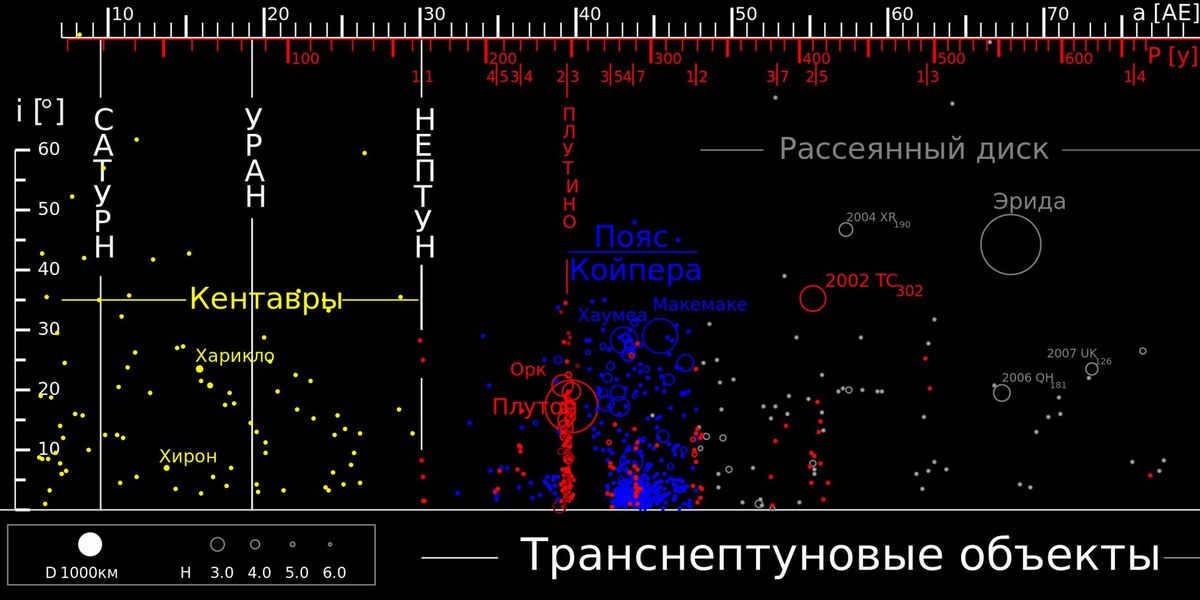
Another peculiar finding arose during the examination of Pluto’s composition. In terms of density, color, and spectral characteristics, it predominantly consisted of ordinary ice. Consequently, from a structural standpoint, it bore a striking resemblance to a colossal comet rather than a planet. (Observe the imagery of Pluto – a wintry, icy realm!)
Furthermore, comparable-sized entities to Pluto have recently emerged within the Kuiper belt. Although Makemake, Sedna, and Haumea were smaller than Pluto, Erida was either comparable in size or even slightly larger! Should it not be granted the status of a planet, making it the tenth in our solar system?
What occurred to the planet Pluto?
During the International Astronomical Union Congress in Prague in 2006, astronomers made the decision to adopt a revised definition of the term planet. Currently, we classify a celestial body as a planet if it meets the following criteria:
- It orbits the Sun and is a satellite of our star, rather than one of the planets.
- The body has enough mass to assume a hydrostatic equilibrium shape, which is close to spherical, under the influence of its gravitational forces.
- It has the ability to clear the area around its orbit of other bodies. This means it must be gravitationally dominant and have no other bodies of comparable size nearby, except for its own satellites.
Based on the latest interpretation, Pluto, similar to Ceres, satisfies the initial two conditions, but does not meet the third condition. It is surrounded by numerous other celestial bodies. Therefore, Pluto can be considered as merely the biggest entity within the Kuiper belt, similar to Ceres and the asteroid belt. This is precisely the reason why Pluto was excluded from the roster of major planets!
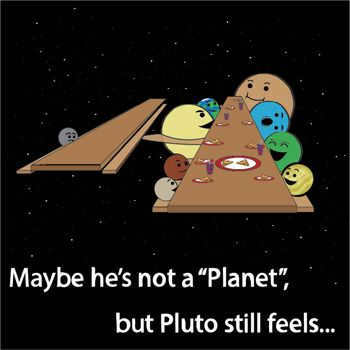
So what shall we name it instead? An asteroid? However, asteroids are just shapeless chunks of rock and metal in comparison to Pluto, which is sizable, spherical, and icy. A comet? Comets are small and irregularly shaped, whereas Pluto is a behemoth in comparison!
The astronomers have decided to introduce a new term – dwarf planets. These are similar to planets (round and large enough to distinguish themselves from the mass of asteroids), but not fully-fledged like Earth, Jupiter, or Neptune.
Not only Pluto, but also Ceres (the largest object in the asteroid belt), Makemake, Erida, and Haumea have been given this designation. Therefore, there are currently 8 recognized planets (or major planets) and 5 dwarf planets in our solar system.
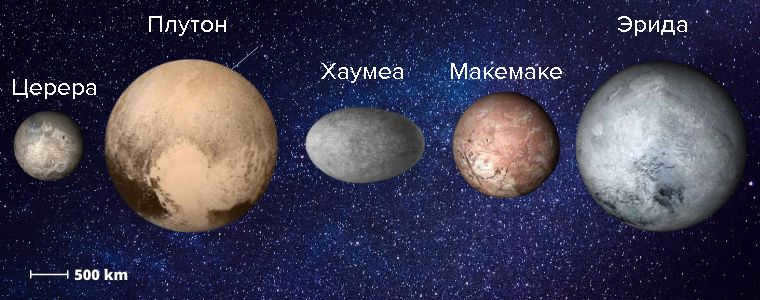
The Present Condition of Pluto
Here, we provide responses to the most frequently asked inquiries regarding the current condition of Pluto.
Does Pluto belong to the solar system?
Undoubtedly, it is. Pluto has not departed anywhere; it is still revolving around Pluto. The alteration lies in Pluto’s classification. It is now categorized as a dwarf planet and no longer regarded as a regular planet within the solar system.
From which year was Pluto no longer considered a planet?
Pluto has not been considered a planet since 2006, when a new definition of the term planet was adopted at the IAU convention in Prague. It is important to note that this definition only applies to planets within our solar system. The term used for planets orbiting other stars is exoplanet. Speaking of exoplanets, there are also a plethora of interesting findings in that field!
Who removed Pluto from its planetary status?
Astronomers, the very individuals who first discovered Pluto, were responsible for its reclassification. The decision was made through a vote by the International Astronomical Union, rather than being attributed to a specific person.
Why is Pluto no longer considered a planet?
Pluto fails to meet the third criterion of the planet definition, which states that a planet must have cleared its orbit of other objects. In addition to Pluto, there are numerous other similar icy bodies orbiting at a similar distance from the Sun, albeit smaller in size.
The location of Pluto, beyond the orbit of Neptune, means that it hasn’t gone anywhere and is still present in our solar system. It is as much a part of the solar system as any other planet, asteroid, or comet.
Last summer, a space probe that passed by Pluto made an astounding discovery: the surface of this dwarf planet is relatively young. Scientists are still trying to understand the reasons behind this phenomenon.
Pluto has remained a mysterious celestial body since its discovery in 1930. Its distant position at the outer reaches of the solar system makes it visible to us only through powerful telescopes. Even then, it appears as a small and faint dot. As a professional astronomer, I have only had the chance to observe Pluto a few times.
In 2006, there was a lot of controversy surrounding Pluto because it was stripped of its “planet” status. This year, astronomers introduced a new category called dwarf planets, which includes Pluto and several large asteroids. Now, Pluto is considered one of the largest trans-Neptunian objects, which are a group of icy asteroids that orbit the Sun beyond Neptune, the furthest planet from the Sun.
Our understanding of Pluto changed significantly in the summer of 2015, when the New Horizons spacecraft flew past it and captured the first-ever photos. Launched ten years prior, the spacecraft was equipped with various instruments, including an exceptional camera, allowing for a detailed study of Pluto. Astronomers were shocked by what they discovered. They had expected to find a surface covered in craters, but that turned out not to be the case.
Pluto: An Exclusive Focus
Our journey to witness the enigmatic Pluto has been an extensive one. When the Hubble telescope captured its initial image in 1994, Pluto appeared as nothing more than a minuscule dot. However, in 2010, a fresh Hubble image revealed a diverse surface, albeit lacking in intricate features. Thankfully, the New Horizons mission revolutionized our understanding by showcasing an astonishing absence of craters on Pluto.
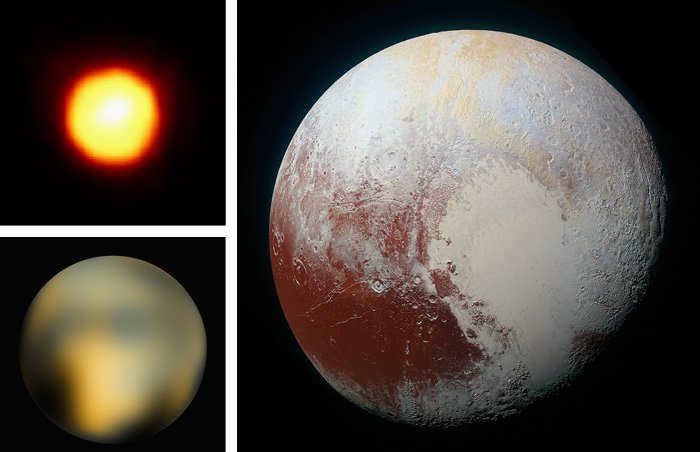
Photos of Pluto: May 16, 1994 (top left), February 4, 2010 (bottom left), July 13, 2015 (right)
The intriguing absence of craters
Why did astronomers anticipate Pluto’s surface to contain numerous craters? This notion arises from the prevalent belief that the solar system autonomously evolved over billions of years. Allegedly, the solar system originated from a vast cloud of gas and dust 4.5 billion years ago. Based on this hypothesis, the majority of the material in the solar system accumulated at the center, forming the Sun. The remaining material flattened into a disk where tiny particles began to coalesce. Over time, these particles gradually grew, resulting in the formation of planets, their satellites, asteroids, and comets.
Naturalistic astronomers hold the belief that celestial bodies beyond the orbit of Neptune are incapable of attaining the size of planets. These diminutive entities, along with the smaller objects encircling the Sun within the planetary region, are commonly referred to as asteroids. It is hypothesized that during the formation of these asteroids, collisions with other minute objects occurred, resulting in an augmentation of their size while leaving behind visible craters on their surfaces.
Craters also form on planets, but the planetary surface is typically more active and dynamic. Unlike asteroids, planets have fewer craters due to various factors such as volcanic eruptions and changing weather patterns which can fill and eventually conceal ancient craters. This explanation is widely accepted among astronomers to account for the relatively small number of impact craters on Earth. In contrast, the Moon is a less active celestial body compared to Earth, with minimal volcanic and weathering activity. As a result, its surface still bears the visible signs of numerous impacts.
Similarly, asteroids and Pluto, which are small objects in the solar system, are believed to lack any signs of geological and weathering processes. As a result, it is expected that their surfaces would be covered in craters. Numerous spacecraft have visited asteroids and captured photographs, revealing the presence of many craters on their surfaces. Most of the moons orbiting planets also exhibit a high number of craters. Therefore, astronomers anticipated that Pluto would have a significantly larger number of impact traces compared to our Moon.
However, to the astonishment of scientists, images taken by the New Horizons spacecraft revealed a surprisingly low number of craters on Pluto’s surface. Interestingly, its largest moon, Charon, possesses more craters than Pluto itself, although even Charon has fewer craters than initially predicted.
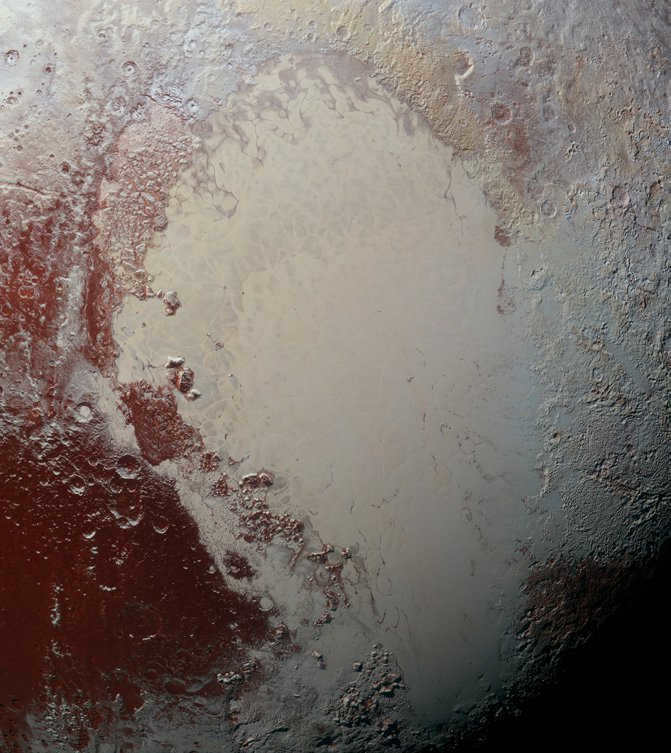
The surface of Pluto is home to the Tombaugh region, which is the most fascinating aspect of the planet. This particular region stands out due to its distinctive heart-shaped appearance. The reason behind its light color is the presence of various glaciers that make up the Tombaugh region. Interestingly, it seems that a portion of the ice in this area has transformed into water. Unlike regular water ice, the glaciers on Pluto mainly consist of nitrogen, with small traces of carbon monoxide and methane. This composition gives them a less viscous nature, making them more prone to melting. However, it is likely that a heat source is required to trigger this transformation.
Within the Tombaugh region, there are several craters, but the western half known as the Sputnik Plain (Sputnik Planum) does not display any visible craters. According to the evolutionary theory, this suggests that the region is relatively young and has formed recently.
Proof of a Dynamic Planet
Why is it that Pluto and Charon have such a limited number of craters? Scientists who adhere to naturalistic principles do not argue that Pluto is not old, but they do believe that its surface is comparatively young. How can the surface be young while Pluto itself is not? Evolutionary scientists propose that the recent geological activity on Pluto has covered up the material that would have otherwise formed numerous craters.
Furthermore, certain glaciers on Pluto’s surface appear to have become active. This is not what one would anticipate on a planet that is ancient and lifeless.
There are indications of recent geological activity on Pluto. The towering mountain ranges on the planet are comparable in height to the Rocky Mountains. Typically, tall mountains would have collapsed under their own weight over time if they were old. However, this has not happened on Pluto, suggesting that the mountains are relatively young. It is possible that the presence of liquid water in Pluto’s interior is accelerating the leveling process, as some planetologists believe based on certain characteristics of the icy surface.
What is responsible for the geological activity on Pluto? Astronomers have put forward two plausible explanations.
The first possibility is that there is an internal heat source. For instance, it has been suggested that Pluto is similar to Earth in that it contains radioactive substances within its core that produce heat. Many scientists believe that this process is what keeps Earth’s interior warm. However, this is not the case for Pluto. It appears that Pluto does not have any radioactive materials, otherwise it would be much denser. In fact, Pluto’s density is quite low, less than half that of Earth. This low density can be attributed to the fact that Pluto is composed of a mixture of ice and rock. This composition lacks the necessary radioactivity to sustain heat on Pluto for billions of years.
Another possible source of heat could be tidal heating. Objects of significant size in outer space have the ability to stretch and compress their smaller counterparts. Scientists have theorized that this process could be the reason why there are no visible craters on the surface of Io, which happens to be Jupiter’s largest moon. They propose that Jupiter’s gravitational forces cause tidal effects on Io, resulting in the formation of numerous volcanoes that periodically reshape the moon’s surface.
If both options are eliminated, how can astronomers account for the appearances of Pluto and Charon? Thus far, no explanation has been provided. It is possible that astronomers might eventually speculate that Pluto and Charon experienced extraordinary catastrophic events in the relatively recent past (within the past few hundred million years). However, resorting to extraordinary events as an explanation is an unfounded method of finding a solution. Since it cannot be substantiated, it can hardly be considered scientific.
Answer from the Bible
What if Pluto is not as ancient as many scientists theorize? If Pluto is relatively young, it would not have had sufficient time to accumulate a significant number of craters. Alternatively, it is possible that Pluto was formed with residual internal heat that continues to exist. This heat could be responsible for geological processes that not only erode many craters but also account for the release of gases from Pluto, resulting in a thin atmosphere.
However, if Pluto is indeed billions of years old, it would not have retained any of its internal heat. Scientists who adhere to the biblical creation account anticipate finding evidence that supports a young age for Pluto. Currently, this is the evidence that we observe.
If the solar system is young, one might question why certain celestial bodies such as the Moon and Mercury exhibit a multitude of craters on their surfaces. One hypothesis suggests that the majority of these craters may be the product of a rapid process employed by God on the fourth day of creation, when He formed the bodies of the solar system. It is possible that God created certain objects with internal heat, such as Io and Pluto, causing their surfaces to be rejuvenated and thereby eradicating the original craters.
Another perplexing issue for those who subscribe to the notion of billions of years is the presence of Pluto’s thin nitrogen atmosphere. Given that Pluto possesses a gravitational force too feeble to retain an atmosphere, one would expect the gases to disperse rapidly. However, if Pluto is only a few thousand years old, it is plausible that it has not had sufficient time to lose its atmosphere.
Pluto, in any case, appears to be one-of-a-kind in comparison to other celestial bodies in our solar system. What could be the reason behind God’s creation of Pluto in such a peculiar manner? Perhaps He intended to perplex our thoughts and demonstrate that He truly fashioned the Universe precisely as described in the Bible?
Pluto has undeniably revealed itself to be a captivating and dynamic world. We are even witnessing the presence of glaciers that contribute to the shaping of the planet’s surface. Glaciers are typically unheard of on celestial surfaces apart from Earth (excluding Jupiter’s moon Europa, which seems to be entirely enveloped in a thick layer of water ice). Devout Christians who firmly believe in the teachings of the Bible are eagerly anticipating new revelations that will enhance our comprehension of Pluto.
Pluto’s moon: an enigmatic world
Charon, the largest and most intriguing of Pluto’s five satellites, continues to puzzle scientists. Despite having more craters than its parent celestial body, Charon still possesses far fewer than expected. This could suggest that Charon is relatively young, according to the creationist perspective, or that the icy surface has undergone recent activity, effectively filling in the craters. Notably, the southern hemisphere of Charon exhibits an unusually low number of craters. However, akin to Pluto, Charon boasts impressive mountain ranges. One particular mountain rises from a depression, resembling a castle surrounded by a moat, yet its origin remains shrouded in mystery.
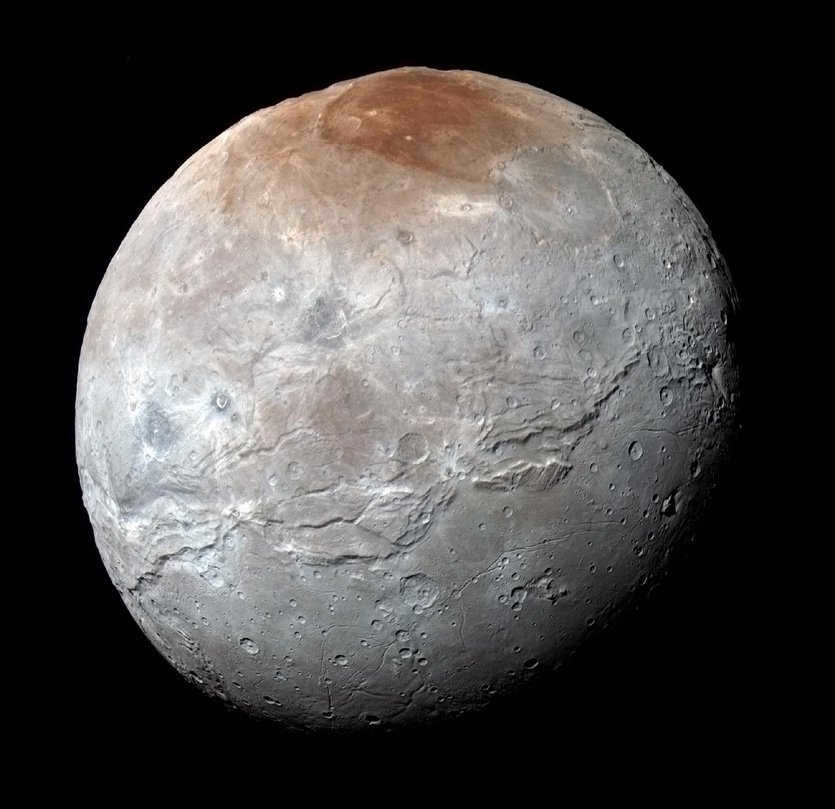
Charon, the largest moon of Pluto, possesses a distinctive surface ice composition when compared to its parent planet.
While Pluto’s glaciers consist primarily of nitrogen and methane, which are similar to the natural gas found on Earth, Charon’s glaciers are predominantly composed of water. The reason for this disparity remains unknown.
Water ice requires significantly higher temperatures to melt compared to other types of ice. Consequently, Charon’s water glaciers are less likely to melt in comparison to those on Pluto. Furthermore, due to its higher density and viscosity, water ice is more resistant to shape change and melting. If Pluto has remained inactive for an extended period, it would exhibit a greater number of craters.
Similar to Pluto, evolutionists can only hypothesize that Charon was geologically active in the not-so-distant past. However, the exact mechanism behind this activity remains unknown. The enigmatic nature of these celestial bodies on the outskirts of our solar system persistently challenges evolutionary theory, serving as evidence for the existence of a Creator.
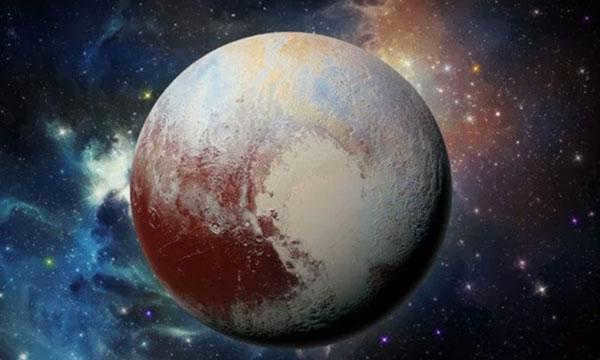
Curious Information
Pluto has been excluded from the list of planets for the past 14 years, resulting in there being 8 planets in the solar system instead of 9. However, many individuals are still unaware of this fact, leading them to be quite astonished when they hear the news. In this article, I will explain the reasons behind Pluto’s classification as a non-planet and reveal its true nature as a different celestial object.
What Defines a Planet?
When the term planet is mentioned, it immediately conjures up an image of a large celestial sphere in the vastness of outer space, with smaller celestial bodies orbiting around it. For many years, Pluto held the title of being the smallest planet in our solar system, until its classification was changed in 2006.
Scientists have based their definition of a planet on the fundamental characteristics of a celestial body. According to this definition, a planet is a spherical object that orbits around the Sun, has its own clear trajectory, and is not a satellite of another celestial body.
Fun fact: the word “planet” originates from the Greek word “wanderer”. In the early days of astronomy, our ancestors believed that planets were wandering stars. However, our understanding of planets has evolved significantly since the invention of the telescope.
The background of Pluto
Percival Lowell, an English astronomer, fulfilled his childhood dream of studying astronomy professionally by building his own observatory. While he had a strong interest in Mars and even wrote books about the possibility of life on the planet, he was also fascinated by the search for “Planet X” that was believed to be affecting Neptune’s motion. To assist him in this quest, Lowell enlisted the help of Clyde Tombaugh. Tombaugh devised an experiment to find this elusive celestial body:
- Over the course of several weeks, he captured daily images of the same section of the sky.
- He meticulously compared the positions of objects within the captured images.
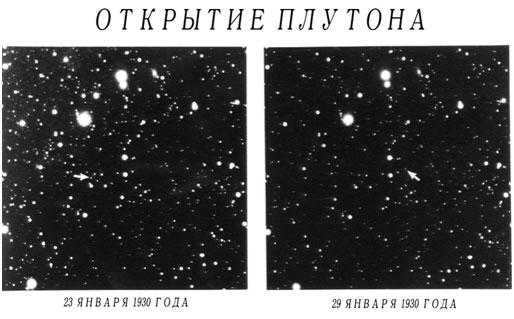
He became fascinated by a celestial body that was visibly moving. He accomplished this feat in 1930. This is how the discovery of Pluto came about, although it did not bear that name at the time.
Pluto was given its name by an 11-year-old girl named Venetia Bernie. She had a strong interest in ancient Roman mythology and was drawn to the name of the God of the underworld, which resonated with the dark and cold nature of Pluto. Interestingly, the official abbreviation for Pluto is “PL,” which are the initials of Percival Lowell.
There were two other contenders for the name of the ninth planet: Minerva and Kronos.
Interesting Facts about the Controversial “Ninth Planet”
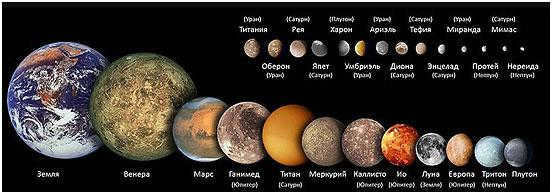
During the time when Pluto held the status of a planet, various intriguing details were ascribed to it.
| There are 5 satellites | Charon with Nyctai, Styx, Kerberus, and Hydra. |
| The composition of Pluto’s atmosphere is nitrogen, methane, and carbon monoxide | Pluto is extremely hazardous for humans. When Pluto is in close proximity to the Sun, its entire atmosphere transforms into gas, while the farther it is from the Sun, the colder it gets, as the entire surface of Pluto is covered in snow. |
| Pluto has a frozen ocean on its surface | There have even been theories suggesting that Pluto contains three times more water than Earth. |
| Pluto’s rotation is retrograde | The Sun rises in the West, not in the East, when compared to Earth’s rotation. |
| It takes 5.5 hours for sunlight to reach Pluto. | It only takes 8 minutes for sunlight to reach Earth. This is due to Pluto’s distance of almost 6 billion kilometers from the hottest celestial body. |
What led to the decision to reclassify Pluto as a non-planet?
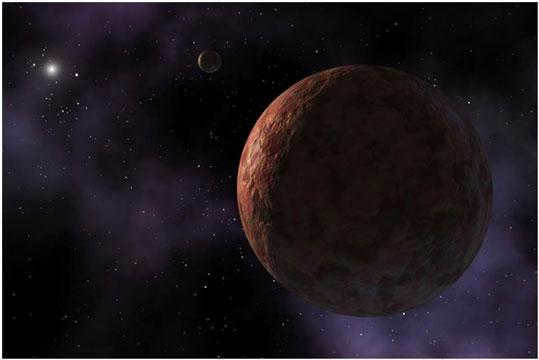
[adsense1].
Scientists theorize that Pluto does not satisfy all the requirements that are necessary for an astronomical object to be classified as a planet. What are those requirements?
| The object must orbit the Sun | Pluto does fulfill this requirement |
| The object must have a spherical shape and a significant mass | Pluto meets this requirement |
| An object cannot be in gravitational dominance with other celestial bodies | This applies to Pluto |
| The object’s orbit must be free of space debris | This is the only requirement that Pluto does not satisfy |
Pluto has been officially classified as a dwarf planet, but there is still a possibility for it to regain its status as the ninth planet in our solar system. In order to achieve this, Pluto would need to clear its orbit by colliding with and absorbing other objects.
What are the advantages of Pluto being classified as a dwarf planet?
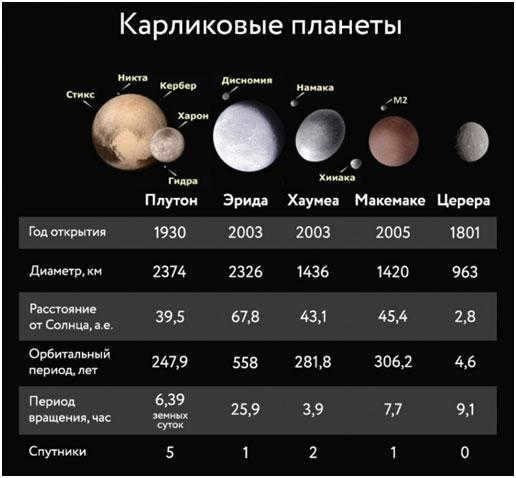
[yandex1].
The demotion of Pluto from planet status was a significant event. Unlike asteroids, which were elevated to the status of dwarf planets, Pluto lost its place in the planet club. The most notable example of this change is Ceres.
However, this change in status has actually led to increased scientific exploration of Pluto. In fact, in 2019, new objects were discovered on the surface of this dwarf planet, further fueling scientific interest.
| Lake Alcyone | According to ancient Roman mythology, this lake served as the entrance to the underworld. |
| Elcano Mountains | These mountains were named after the renowned navigator Juan Sebastian Elcano. |
| Hoon Ahpu Valleys | In Mayan mythology, these valleys were associated with the twin hero who defeated the God of the underworld. |
There are 11 more fascinating objects that I haven’t mentioned. If you’re interested, you can visit a planetarium or explore dedicated websites that provide detailed information about discoveries on Pluto and beyond.
What led to the reclassification of Pluto as a non-planet?
Discovering the Rejection of Pluto’s Planetary Status: A Tale from My Family
Like many others, I was unaware that Pluto had been stripped of its planet status until the summer of 2019. It was during a trip to the planetarium with my kids that I discovered this surprising fact. We were participating in a space-themed quiz when the question about the number of planets in the solar system came up. I confidently gave the wrong answer, which resulted in laughter from the other children in attendance. It was a humbling moment for me, especially in front of my sons who believed their mom knew everything. On the way to the planetarium, I had regaled them with fascinating facts, so this revelation was quite embarrassing. Despite excelling in geography during my school years, I had forgotten how much time had passed since then and how science constantly evolves.
Overall, the universe is awe-inspiring, expansive, enigmatic, and incredibly profound. Despite the fact that Pluto is no longer classified as a planet, it’s possible that in the near future we will all learn that astronomers have made a groundbreaking discovery and found a new planet, or maybe not! This would be a monumental revelation for our time! However, our primary focus should be on taking care of our own planet!
Pluto is a dwarf planet located in the Kuiper belt. An intriguing point to note is that up until 2006, Pluto was considered the ninth planet in our solar system.
This article will delve into the reasons behind its demotion. If you have a fascination with space and all things related, this will surely capture your interest.
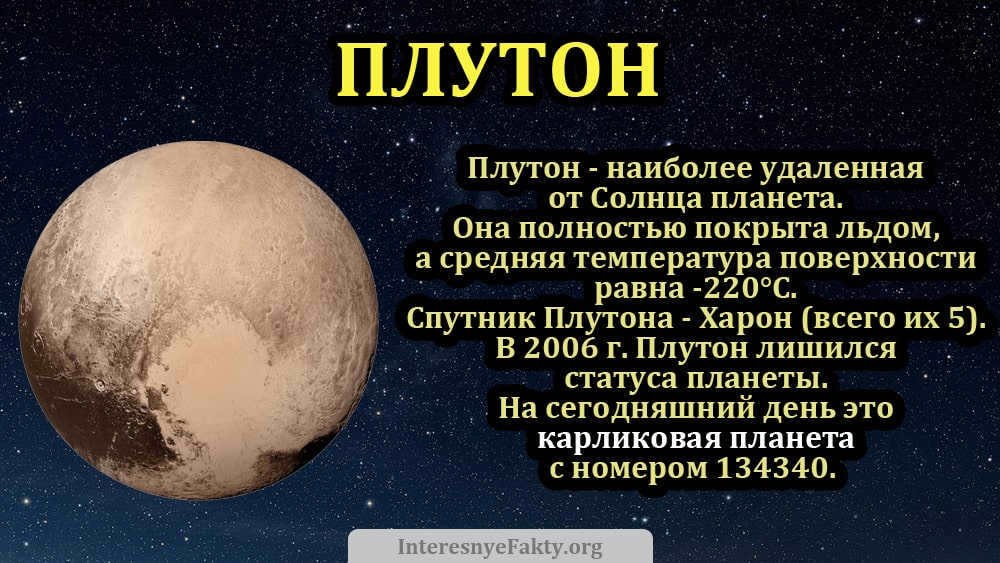
The Mysterious “Planet X”
During the late 19th century, scientists proposed the existence of an additional planet within our solar system. This hypothesis was formulated based on mathematical calculations.
It is interesting to note that at that time, the most recently discovered planet was Uranus, and it was only later that Neptune was discovered. Nevertheless, astronomers were convinced that there was another celestial body, which they referred to as “Planet X”.
After an extensive and challenging search, Pluto was finally discovered in 1930, revealing the identity of the elusive “Planet X”.
New findings
Following that, for 76 years, Pluto was acknowledged as the ninth planet in the solar system. However, in 2006, scientists reevaluated their stance on it.
This is because the accepted belief regarding Pluto’s mass, which was believed to be nearly equal to that of Earth, was disproven.
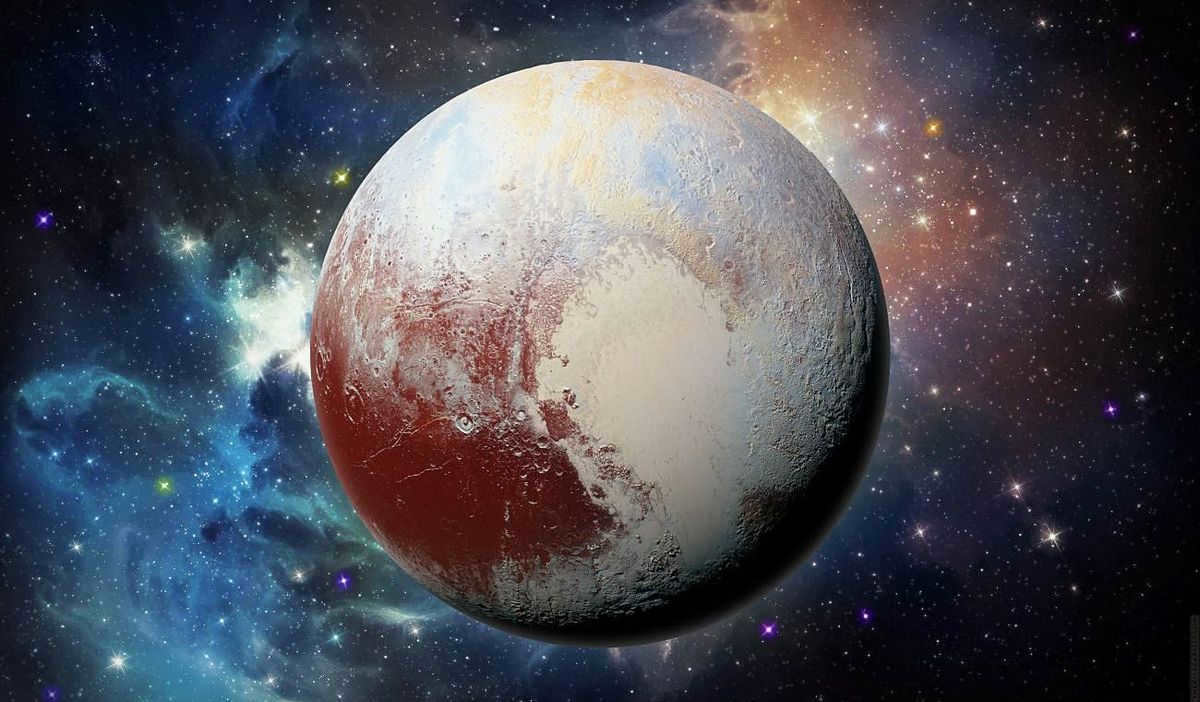
Actually, the weight of the farthest planet from the Sun turned out to be approximately 0.2% of the Earth’s weight. Furthermore, Pluto’s size was 5 times smaller than that of Earth.
Considering these and other factors, scientists revoked Pluto’s status as a planet within the solar system. Subsequently, it was simply classified as a dwarf planet.
Unique trajectory
The path that Pluto follows around the Sun sets it apart from the other 8 planets, as it possesses a distinct oval shape. As a result, the movement of this dwarf planet is quite erratic.
Astronomers face challenges in accurately predicting Pluto’s rotation due to the gradual shifting of its orbit over time.
It is worth noting that Pluto, along with Venus and Uranus (for more intriguing facts about Uranus, click here), exhibits a clockwise movement, and a day on Pluto lasts approximately 6.3 Earth days. A complete revolution around the Sun for Pluto takes 248 Earth years to accomplish.
Moons of Pluto
Pluto has a total of 5 moons. The biggest one is called Charon, and it was first identified in 1978.
What’s interesting is that the remaining 4 moons, namely Nycta, Hydra, Kirby, and Styx, were only found between 2005 and 2012. All of them are relatively small and have nearly circular paths around Pluto.
Due to its vast distance from Earth, Pluto remains a mystery to scientists. There is a prevailing belief that the celestial body is composed of a combination of rocks and ice. The main components of its atmosphere are nitrogen, methane, and carbon monoxide.
Pluto experiences a greenhouse effect due to the presence of methane, resulting in an average surface temperature of approximately -220 °C.
In recent times, astronomers have discovered a direct correlation between the atmospheric pressure on Pluto and its distance from the Sun.
Advanced technology in the field of space exploration
Thanks to the development and utilization of cutting-edge telescopes, scientists have made remarkable discoveries related to the celestial objects surrounding the planet Pluto.
This research has revealed a multitude of space entities that were subsequently designated as the Kuiper belt due to their significant numbers.
As of now, more than one hundred cosmic bodies with diameters exceeding 100 kilometers have been identified. The presence of the Kuiper Belt played a key role in the reclassification of Pluto from a planet to a different celestial category.
In addition, the Hubble spacecraft played a crucial role in the identification of a new object, which was later named Erida. Notably, Erida was found to be situated even farther away from the Sun than Pluto. Subsequently, several other similar celestial entities were also discovered.
An interesting fact is that if Pluto had not been excluded from the list of planets in the solar system, then all these new bodies would also have to be called planets, as they had a composition very similar to that of Pluto.
Reevaluating Pluto’s classification
As mentioned earlier, in 2006, Pluto was reclassified as a dwarf planet because it no longer met the criteria to be considered a full-fledged planet.
This significant decision was made at the Congress of the International Astronomical Union, which was attended by approximately 3000 participants.
They determined that an object vying for planet status must meet the following criteria:
- orbit the Sun in its own path;
- have sufficient mass to form a spherical shape;
- not be a satellite of another planet;
- Pluto possesses a strong gravitational field, enabling it to clear its orbit of other celestial objects.
However, despite meeting the first three criteria for being classified as a planet, Pluto’s mass prevented it from fulfilling the fourth requirement of clearing its orbit of space objects.
Consequently, all such celestial bodies were categorized as “dwarf planets”.
Interestingly, the debate surrounding Pluto’s planetary status gave rise to fantastical rumors about the mysterious planet Nibiru, which supposedly poses a threat to our planet in the near future. This information is definitely worth exploring.
Lastly, we highly recommend watching a fascinating BBC video about the planet Pluto. Make sure to watch it until the end – it’s incredibly captivating!





